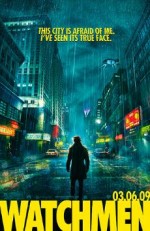
Comic book fans, we’ve got another one– another superhero flick to round out last year’s “Iron Man” and “The Dark Knight”. Whether you’ve only just discovered the movie through the trailer or you’ve been an avid Alan Moore fan for years, you are probably highly anticipating “Watchmen,” hitting theaters on March 6.
“Watchmen” revolves around the tale of a band of masked heroes who have retired from duty. When the Comedian, one of the original Watchmen, is murdered, the group must re-join forces to uncover the killer. The entire premise is designed to deconstruct our fascination with superheroes and their mythos within an alternative United States that is heading towards a nuclear war with the Soviet Union. And it does a brilliant job at challenging our ideas of humanity, relationships, and just “who watches” superheroes when they need help.
The beauty of the “Watchmen” graphic novel is its ability to tell a story through multiple layers within the comic pages and artwork themselves. Each page is layered with symbols, such as the smile-face with blood, that help provide clues as to what is really going on in the comic book. The interesting challenge with adapting a comic book like “Watchmen” is how to take visual cues that can only be told through the pace of comic books and translate them to the screen. Alan Moore, the writer of “Watchmen”, “V for Vendetta”, and “From Hell,” was the first to denounce the adaptation of his works as “impossible.”
Moore originally wrote the book in 1986 in twelve installments for DC comics, with the idea originating from several unused DC characters. This was eventually reworked to allow Moore to write several new characters, rather than just writing new plots for old characters. Moore realized that by making the characters similar to other superheroes, like Night Owl is to Batman, the audience would be able to resonate with the character without him having to write within the rules of an already established character’s universe. Artist Dave Gibbons took up the task of illustrating Alan Moore’s 101 page single-spaced manuscript into a working comic book. What resulted was the comic book as it stands today.
From there, the comic book began its journey to the screen, despite legal battles over the film rights and the usage of the book itself. Moore and Gibbons originally tried to purchase the rights to their own material, which is unfortunately a common problem when a book is published by a major publishing house. Moore ultimately ended up leaving DC comics over the fight for the rights of his characters in “Watchmen” and “V for Vendetta”. The comic book then traveled to Hollywood where Twentieth Century Fox bought the rights to the film adaptation. The project was put up for grabs, and Warner Brothers snagged it to be produced by Zack Snyder. While Gibbons became an advisor to the film, Moore persistently will not be involved with any film version of his work.
So, there you have it – the lifetime of a single comic book from manuscript to theaters. After reading the heart-wrenching tale of the “Watchmen” characters, all I can hope to do is wait and see if the movie holds true to the book. I hope it will.






